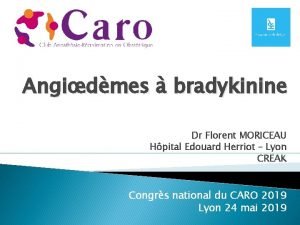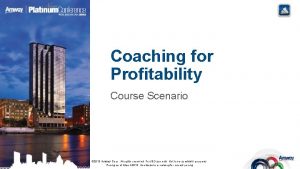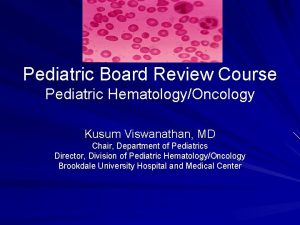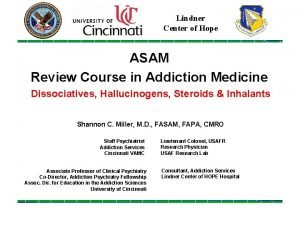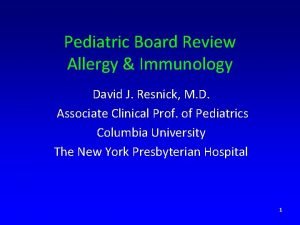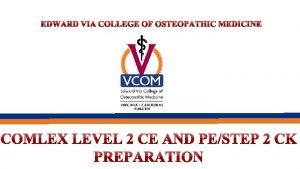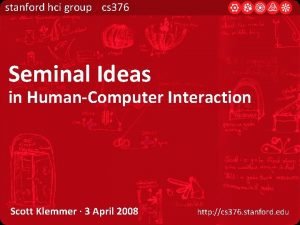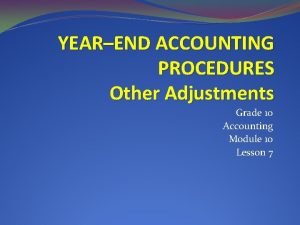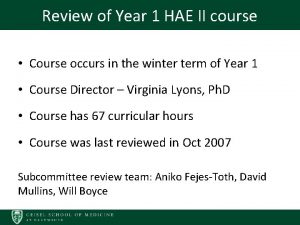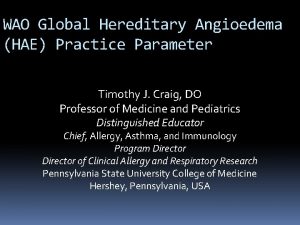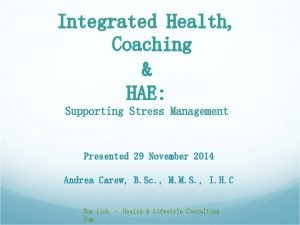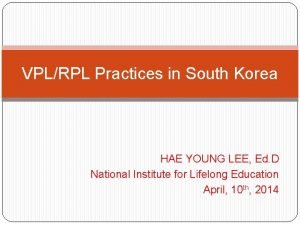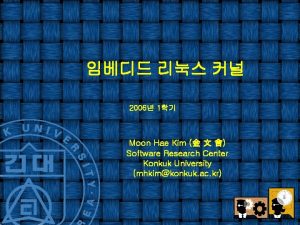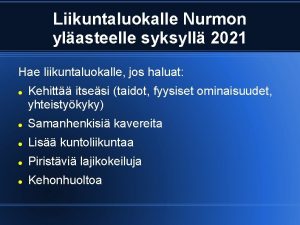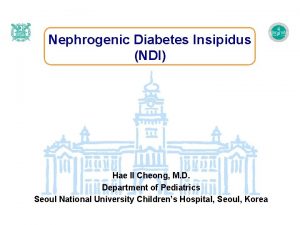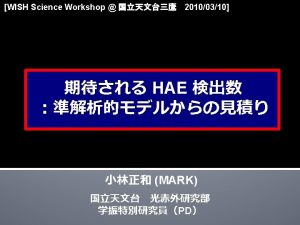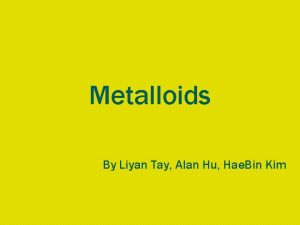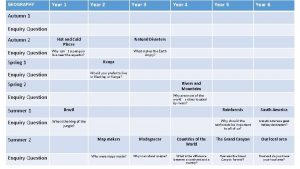Review of Year 1 HAE I course Course





















![Measures of Quality – Course Evaluation scale [1=poor; 2=fair; 3=good; 4=very good; 5=excellent] HAE Measures of Quality – Course Evaluation scale [1=poor; 2=fair; 3=good; 4=very good; 5=excellent] HAE](https://slidetodoc.com/presentation_image_h/2c9f584c3d798a53581cda1232f9631a/image-22.jpg)







- Slides: 29

Review of Year 1 HAE I course • Course occurs in the fall term of Year 1 • Course Director – Virginia Lyons, Ph. D • Course has 50 curricular hours • Course was last reviewed in Aug 2015 Review presented to MEC March 2017

Action Plan from Prior Review • Session objectives have been drafted for the course introduction and lab orientation; these are now on Ilios✓ • With MEC approval an objective will be added that states: “Develop and demonstrate self-directed learning skills by coming prepared for class sessions” ✓ [wording was revised slightly since “self-directed” might not be appropriate based on the LCME definition] • Key words will be added to session objectives where appropriate, for example the objective used as an example was revised to state: “Describe the location, structure and general function of the organs in the upper abdomen, namely the liver, gallbladder, stomach, proximal parts of the duodenum, pancreas and spleen. ” ✓ [several areas still need work]

Action Plan from Prior Review • A meeting has occurred between a representative of the Health and Values VIG group and the course director. The VIG group is investigating the potential to add health and values content to the HAE Y 1 PBL case. ✓ [content was added to PBL case, and case was used AY 15 -16. ] • Readiness quizzes have been moved out of class sessions and are due prior to the laboratory. This encourages students to prepare prior to the lab session and the subsequent small group conference. ✓ • Based on student feedback, the laboratories for the pelvis and perineum unit will be prosection-based during AY 15 -16. ✓

Course Objectives Course objective Mapping to program objective

Course Objectives – Comments • The content and number of course objectives seems appropriate; objectives cover the content mentioned in the USMLE content outline for 2016 • The mapping of course objectives to the Geisel competencies in Ilios was reviewed by the course director and checked for accuracy; changes were conveyed to Geisel computing

Format of Course & Session Objectives • Course objectives are provided in the syllabus • Course objectives are written in the correct format • Session objectives are provided in the course materials • Session objectives are written in the correct format with the exception of #4 for Abdomen session 3 (“visualize” is not a measureable verb)

Issues of Redundancy • Ilios was used to search general anatomical terms such as “stomach”, “vertebra” and “uterus” • The subcommittee did not find unplanned redundancy in the HAE course; when redundancy was present it was appropriate (e. g. the stomach is discussed in detail in HAE and the SBM GI course has two slides to review stomach anatomy before discussing peptic ulcer disease) • Some terms that should have produced results in Ilios for HAE (e. g. uterus) did not because the session objectives used broader terms (e. g. pelvic viscera)

Health and Values Goals Ethics – “Identify key concepts in health care ethics and demonstrate an ability to recognize ethical issues arising in patient care and population health and to think critically and systematically in applying an ethical analysis” Cultural Awareness – “Demonstrate an understanding and skill in managing patient care of people of diverse cultures, social, economic standing and belief systems” Health Equity – “Identify the root causes and approaches for addressing health disparities locally and globally” Resilience – Demonstrate knowledge of skills and practices to prevent and address stress and maintain resilience in caring for patients and oneself Compassion and Empathy – “Demonstrate abilities to understand each patient’s experience of illness, adapt scientifically appropriate care to conform to that patient’s needs, and communicate in terms that each patient can understand” There also are synergies to health law, communication skills, professionalism (as LCME requires).

Health and Values Content What Health and Values Program material (healthcare ethics, cultural awareness, health equity, resilience, compassionate care) is presented in the course? • The HAE course has a joint session with On Doctoring that discusses issues of compassion, empathy, respect and ethics with regard to body donation. The objectives for this session are listed in the On Doctoring course (and not the HAE course), thus students might not consider it to be part of HAE. • During AY 15 -16 HAE had a PBL case that addressed issues of ethics, cultural awareness, compassion and empathy, however the timing of the case during the first week of classes was heavily criticized by students and it was not used in AY 16 -17

Health and Values Content Are the Health and Values topics noted in the course and session objectives? • Several course objectives in On Doc (for joint session) mention H&V: – 3. Demonstrate sensitivity to patient values, life circumstances, and culture – 17. Exemplify the highest standards of ethical, professional, and personal behavior – 22. Demonstrate professional and ethical behavior including preparation and active participation in all aspects of the course. – 27. Employ resilience skills to cope with professional and personal challenge • Two session objectives elude to H&V but don’t explicitly state it: – Discuss ways the relationship between physicians and patients can be at its best. – Discuss ways the students would want to be honored if they were an anatomical "body" donor.

Health and Values Content What do the student evaluations indicate regarding Health and Values teaching?

Health and Values Content What do the student evaluations indicate regarding Health and Values teaching? • “I appreciated [the body donation session]…I wish there were more reflections along the way about the lab experience and I hope that we have a set-aside period before approaching the head and face. ” • “I’m not sure that the anatomy material lends itself to discussion of these topics in the depth they deserve. ” • “In small group I see several opportunities to bring together ethical topics. As part of the cases, it would be possible to write a follow-up question to the effect of “The 8 year old patient’s parents do not want her to get a blood transfusion. What would you do? ” • “In terms of cultural awareness, since most of our donors were white, I wonder how these structures look on people of different backgrounds. Would it be possible to incorporate more images of people from different racial and ethnic backgrounds in our i. Books? ”

Summary of Objectives/Course Content • Course objectives seem appropriate and do not need revision • Some session objectives should be revised to include key words for the purpose of curriculum mapping • The course should explore reinstating the PBL case or other opportunities suggested by students to incorporate Health and Values material

Course Learning Opportunities • • Lecture 1 hr. (2%) Large Group Case-based Flipped Sessions 12 hrs. (24%) Small Group* Case-based Flipped Sessions 12 hrs. (24%) Laboratory 25 hrs. (50%) *Each small group consists of 16 -20 students, thus is classified as a “large group” on Ilios (>12 students) The course offers self-assessment materials and optional review sessions prior to quizzes and the final exam.

Summary regarding Pedagogy • The course has a nice mix of active pedagogies that is viewed as a strength by students (see slide 23) • Over the last three years, the course has experimented with the percentage of small group vs. large group discussion sessions. Students like the intimacy of the small group sessions, but seem to prefer large group sessions for particularly challenging topics that are best explained by a faculty member with expertise in that area; the current percentages reflect these views

Assessment • • • 4 Written Quizzes (50% of course grade) Final Written Exam (20% of course grade) Final Practical Exam* (20% of course grade) Readiness Quizzes (5% of course grade) Team Performance✝ (5% of course grade) *Students must pass the practical exam to pass the course ✝ Team performance includes attendance at required sessions, punctuality, preparation and engagement, and participating in peer feedback activities

Assessment for Course Objectives • Objectives 1 -7 are knowledge based and are assessed by quizzes and exams • Objectives 8 -14 relate to communication skills, team skills, problem-solving skills and professionalism. These skills are assessed by both faculty and students in case-based sessions and the laboratory. Students receive formative oral feedback from faculty during an individual meeting, and formative written feedback from their anatomy team members (objective 17) • Objectives 15 -16 are assessed by the faculty, e. g. if a student is struggling in the course, did they take the initiative to seek out help; did they consider the feedback given in the oral and written evaluations and adjust their behavior if necessary

Summary regarding Assessment • Quizzes and exams assess knowledge objectives and problem-solving skills (via questions that require application of knowledge); incorporation of the latter promotes critical thinking skills • Other skills are assessed by both faculty and students during class sessions, and students receive feedback on these skills

Measures of Quality – Graduation Questionnaire Data from AAMC Graduation Questionnaire

Measures of Quality – Step I 2014* 2015* 2016* Means 14 -16 Biochemistry 0. 22 0. 03 -0. 04 0. 07 Biostatistics 0. 08 0. 29 N/A 0. 185 (14 -15) Genetics 0. 28 0. 09 -0. 36 0. 003 Gross Anatomy/Embryology 0. 14 0. 16 -0. 12 0. 06 Histology/Cell Biology 0. 23 0. 07 -0. 09 0. 07 Microbiology/Immunology 0. 39 0. 02 -0. 01 0. 13 Pathology 0. 20 0. 12 -0. 10 0. 07 Pharmacology 0. 12 -0. 02 0. 03 Physiology 0. 25 0. 11 0. 06 0. 14 TRADITIONAL CORE DISCIPLINES *values reported for core disciplines are SD above the US/Can mean for Geisel mean scores

Measures of Quality – Course Evaluation Overall Quality - Year 1 courses AY 14 -15 AY 15 -16 Basic Science of Microbial Disease 3. 94 4. 10 Biochemical and Genetic Basis of Medicine 4. 34 4. 40 4. 54 Cells, Tissues and Organs 4. 07 4. 06 4. 21 Human Anatomy and Embryology I 4. 35 4. 04 4. 61 Human Anatomy and Embryology II 4. 57 4. 43 Immunology 3. 67 3. 94 Metabolic Basis of Disease 4. 35 4. 48 Neuroscience 3. 59 3. 32 On Doctoring 3. 74 4. 10 Pathology 3. 22 3. 06 Patients and Populations N/A 2. 77 Physiology-Cardiovascular 3. 23 3. 41 Physiology-Endocrine 3. 76 3. 52 Physiology-Renal 4. 19 3. 63 Physiology-Respiration 3. 34 3. 41 Virology 3. 77 3. 83 scale [1=poor; 2=fair; 3=good; 4=very good; 5=excellent] AY 16 -17 3. 88 3. 80
![Measures of Quality Course Evaluation scale 1poor 2fair 3good 4very good 5excellent HAE Measures of Quality – Course Evaluation scale [1=poor; 2=fair; 3=good; 4=very good; 5=excellent] HAE](https://slidetodoc.com/presentation_image_h/2c9f584c3d798a53581cda1232f9631a/image-22.jpg)
Measures of Quality – Course Evaluation scale [1=poor; 2=fair; 3=good; 4=very good; 5=excellent] HAE AY 14 -15 (91. 5%)* HAE AY 15 -16 (94. 7%)* HAE AY 16 -17 (94. 6%)* Overall satisfaction of course 4. 35 4. 04 4. 61 Clarity of learning objectives 4. 26 4. 08 4. 70 Organization of the course 4. 19 3. 87 4. 46 How well the course introduced me to this discipline 4. 49 4. 16 4. 75 Congruence of assessment questions to material emphasized in course 4. 20 4. 11 4. 52 *student participation rate on course evaluation

Measures of Quality – Student Comments Strengths The following components were mentioned most frequently as strengths of the course (number of comments in parentheses): • small group conferences (23) • large group discussions (12) • ibooks (11) • case-based approach of the course (8) • dissection labs (7) • variety of formats offered in the course (6) “I liked the case-based style of the large and small group discussions. They were very helpful in solidifying my knowledge of important concepts and clarifying difficult ones. ” “I appreciated that there were several different types of learning incorporated into the class (lab, small group, large group, readiness quizzes). It helped me keep on top of the material, since we were using it and building on it fairly consistently. ”

Measures of Quality – Student Comments Suggestions for Improvement The following components were mentioned most frequently as areas for improvement (number of comments in parentheses): • • • ibooks (14) would like more lectures/large group discussions (7) prosection format of pelvis (5) more practicals or optional lab reviews (3) big picture reviews should be earlier in the term (2) schedule issues, e. g. having lab the day after a quiz (2) “Most of the i. Books were well organized, but there were a couple of chapters that were confusing and had information unnecessarily repeated. ” “Having a few more large group discussions would be helpful for some of the more complex topics. ”

Measures of Quality – Student Comments Other issues from student comments “At certain points, gender and sex were conflated innapropriately. For example a slide labeled "sexual response in women" should have said "sexual response in females. " It also would have been important (if at some point during this first term, perhaps in HAE) if this point was made about distinguishing sex and gender. Trans men might still have ovaries. Trans women might still have prostates. How does the process of genital development different for individuals who are intersex or have differences in sexual development (DSD)? Even if this content will be covered later, it was NOT at all for our entire first term. I have noticed many of my peers and sometimes instructors use imprecise language discussing gender. We need to take a moment and center the importance of words. . . This matters hugely in caring for trans and gender nonconforming patients. I see the omission as a huge oversight and opportunity for improvement. ”

Summary regarding Measures of Quality • The HAE I course is a solid course in the Y 1 curriculum that is consistently rated in the “very good to excellent” range • The course was very well received by students, with particular appreciation for the case-based approach and course ibooks • Students indicate that improvements can be made in some of the ibook chapters and with the pedagogy for certain sessions (e. g. prosection format of pelvis)

Recommendations • Revise several session objectives to include key words and replace the word “visualize” in objective 4 for Abdomen session 3 • Explore opportunities to include health and values content either by reinstating the PBL case or considering student suggestions; ensure correct terminology is used for gender • Revise ibook chapters that are less clear with regard to organization of the material • Reevaluate the pedagogy for the pelvic labs (prosection vs. dissection) and consider whether additional large group sessions would be beneficial to the course

Action Plan • When the competency mapping was reviewed, key words were added to session objectives for sessions on the mediastinum, pelvic viscera and perineum; “visualize” was replaced with a measureable verb • As part of the P&P course, a student group developed an improvement plan on how to incorporate ethics into the anatomy course. The course director will meet with this group and Bill Nelson to explore ways to implement their suggestions, for example incorporating the objectives of the joint HAE/On Doc session into the HAE course. Additionally, the placement/topic of the PBL case will be reevaluated. • Terminology for sex and gender will be corrected in ibooks and faculty will be educated on correct usage

Action Plan • Some chapters of the ibooks (e. g. abdomen) have already been revised and this process will continue during the spring and summer. 4 th year elective students have also contributed new clinical content to the ibooks, e. g. FAST exam (focused assessment with sonography for trauma) in the trunk chapters • The pelvic sessions will be revised to include a mix of dissection and prosection • Faculty-led optional lecture reviews will be provided before each assessment with topics determined by students
 Hi haec hoc
Hi haec hoc Presentation fon
Presentation fon Cleanliness
Cleanliness Hae nang maew
Hae nang maew Hic haec hoc
Hic haec hoc Shire hae
Shire hae Hae opintotukea
Hae opintotukea A scots farewell poem
A scots farewell poem Leavers poem
Leavers poem Mid year budget review
Mid year budget review End of year review objectives
End of year review objectives Amway 600 pv
Amway 600 pv Mid year budget review
Mid year budget review Chapter review motion part a vocabulary review answer key
Chapter review motion part a vocabulary review answer key Uncontrollable spending ap gov
Uncontrollable spending ap gov Narrative review vs systematic review
Narrative review vs systematic review Search strategy example
Search strategy example Narrative review vs systematic review
Narrative review vs systematic review Pediatric hematology oncology board review questions
Pediatric hematology oncology board review questions Hbs practice test
Hbs practice test Dr henry lindner
Dr henry lindner Ca regulatory review course
Ca regulatory review course Allergy board review course
Allergy board review course Online comlex level 2 ce review course
Online comlex level 2 ce review course Mit csail hci course review
Mit csail hci course review Cut brick lengthwise
Cut brick lengthwise Course title and course number
Course title and course number Chaine parallèle muscle
Chaine parallèle muscle Spot forward rate formula
Spot forward rate formula Adjustments in accounting grade 10
Adjustments in accounting grade 10





